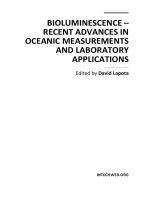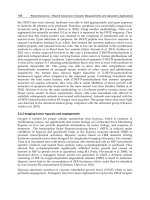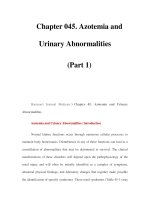Pathology and Laboratory Medicine - part 1 pot
Bạn đang xem bản rút gọn của tài liệu. Xem và tải ngay bản đầy đủ của tài liệu tại đây (1.29 MB, 49 trang )
PATHOLOGY AND LABORATORY MEDICINE
C
ARDIAC
M
ARKERS
S
ECOND
E
DITION
EDITED
BY
A
LAN
H. B. W
U
C
ARDIAC
M
ARKERS
S
ECOND
E
DITION
EDITED
BY
A
LAN
H. B. W
U
Cardiac Markers
00/Wu(036-0)/FM/F04.23.03 4/23/03, 12:41 PM1
Pathology and Laboratory Medicine
Series Editors: Stewart Sell and Alan H. B. Wu
Cardiac Markers, Second Edition, edited by Alan H. B. Wu, 2003
Clinical and Forensic Applications of Capillary Electrophoresis, edited by John R. Petersen
and Amin A. Mohammad, 2001
Cardiac Markers, edited by Alan Wu, 1998
Clinical Pathology of Pancreatic Disorders, edited by John A. Lott, 1997
Molecular Diagnostics: For the Clincoal Laboratorian, edited by William B. Coleman
and Gregory J. Tsongalis, 1997
00/Wu(036-0)/FM/F04.23.03 4/23/03, 12:41 PM2
Humana Press Totowa, New Jersey
Cardiac Markers
Second Edition
Edited by
Alan H. B. Wu, PhD
Department of Pathology and Laboratory Medicine
Hartford Hospital, Hartford, CT
Foreword by
William E. Boden, MD, FACC
Professor of Medicine
University of Connecticut School of Medicine
Director, Division of Cardiology
Program Director, The Henry Low Heart Center
Hartford Hospital
Hartford, Connecticut
00/Wu(036-0)/FM/F04.23.03 4/23/03, 12:41 PM3
© 2003 Humana Press Inc.
999 Riverview Drive, Suite 208
Totowa, New Jersey 07512
humanapress.com
All rights reserved.
No part of this book may be reproduced, stored in a retrieval system, or transmitted in any form or by any means,
electronic, mechanical, photocopying, microfilming, recording, or otherwise without written permission from the
Publisher.
All authored papers, comments, opinions, conclusions, or recommendations are those of the author(s), and do not
necessarily reflect the views of the publisher.
For additional copies, pricing for bulk purchases, and/or information about other Humana titles, contact Humana at the
above address or at any of the following numbers: Tel.: 973-256-1699; Fax: 973-256-8341; E-mail:
or visit our Website: .
This publication is printed on acid-free paper. ∞
ANSI Z39.48-1984 (American Standards Institute) Permanence of Paper for Printed Library Materials.
Cover illustration: Cardiovascular Toxicology, v1, n4. Used with permission.
Cover design by Patricia F. Cleary.
Photocopy Authorization Policy:
Authorization to photocopy items for internal or personal use, or the internal or personal use of specific clients, is granted
by Humana Press Inc., provided that the base fee of US $20.00 is paid directly to the Copyright Clearance Center at 222
Rosewood Drive, Danvers, MA 01923. For those organizations that have been granted a photocopy license from the
CCC, a separate system of payment has been arranged and is acceptable to Humana Press Inc. The fee code for users
of the Transactional Reporting Service is: [1-58829-036-0/03 $20.00].
Printed in the United States of America. 10 9 8 7 6 5 4 3 2 1
Library of Congress Cataloging-in-Publication Data
Cardiac markers / edited by Alan H. B. Wu.–2nd ed.
p.;cm.–(Pathology and laboratory medicine)
Includes bibliographical references and index.
ISBN 1-58829-036-0 (alk. paper) eISBN 1-59259-385-2
1. Coronary heart disease–Serodiagnosis. 2. Biochemical markers. I. Wu, Alan H. B. II. Pathology and laboratory
medicine (Unnumbered)
[DNLM: 1. Myocardial Infarction–diagnosis. 2. Angina, Unstable–physiopathology. 3. Biological Markers.
4. Heart Failure, Congestive–diagnosis. 5. Myocardial Ischemia–diagnosis. 6 Troponin–diagnostic use. WG 300
C2668 2003]
RC685.C6 C265 2003
616.1’23075–dc21 2002038720
00/Wu(036-0)/FM/F04.23.03 4/23/03, 12:41 PM4
Dedication
This book is dedicated to my parents, my loving wife, Pam, and to our children
Ed, Marc, and Kim, whose career journals have only just begun.
v
00/Wu(036-0)/FM/F04.23.03 4/23/03, 12:41 PM5
00/Wu(036-0)/FM/F04.23.03 4/23/03, 12:41 PM6
Foreword
vii
The management of patients with acute coronary syndromes (ACS) has evolved
dramatically over the past decade and, in many respects, represents a rapidly moving
target for the cardiologist, internist, emergency medicine specialist, intensivist, and
clinical pathologist—all of whom seek to integrate these recent advances into contem-
porary clinical practice.
Unstable angina and non-ST-segment elevation myocardial infarction (MI) comprise
a growing percentage of patients with ACS and is emerging as a major public health
problem worldwide, especially in Western countries, despite significant improvements
and refinements in management over the past 20 years. In the United States alone, over
2.3 million people are admitted to coronary care units annually with either unstable
angina or acute MI, the great majority of whom now present with non-ST-segment eleva-
tion ACS.
Consequently, much attention has been directed toward optimizing the diagno-
sis and management of such patients, where risk stratification remains a pivotal
component to sound clinical decision-making. The clinical spectrum of ischemic heart
disease is diverse, ranging from silent ischemia to acute MI to congestive heart failure.
Fundamental initial components of assessing a patient with ischemic heart disease—and
properly gauging risk—include the clinical history, physical examination, 12-lead elec-
trocardiography, and, increasingly, the measurement of biochemical markers.
Over the past decade, however, there has been a progressive evolution of cardiac
marker testing in patients with ACS, MI, and CHF. Not only has this resulted in a
dramatic shift in how we view the diagnosis of these clinical conditions, but it has also
extended the role of cardiac marker testing into risk stratification and guidance of treat-
ment decisions. By the year 2000, the development of highly sensitive and cardiac-
specific troponin assays had resulted in a consensus change in the definition of acute
MI, placing increased emphasis on cardiac marker testing with troponins as the new
“gold standard.” Furthermore, and perhaps more importantly, the role of the troponins
as superior markers of subsequent cardiac risk in acute coronary syndrome patients has
now become firmly established.
But, with so much attention directed at troponin as the dominant cardiac marker, it
has likewise become increasingly clear that, for both diagnostic and risk stratifica-
tion purposes, cardiac troponin testing alone may only quantify risk incompletely for
many subsets of ACS, MI, and CHF patients. For example, the use of high-sensitivity
(hs) C-reactive protein (CRP) and other novel inflammatory markers may add sig-
nificantly to our ability to correctly identify patients presenting with ACS who are at
high risk for future cardiovascular events. The predictive value of CRP appears to be
independent of, and additive to, troponin. Individuals with evidence of heightened
inflammation may benefit most from aggressive life-style modification and intensifi-
cation of proven preventive therapies such as aspirin and statins. Moreover, the ben-
efits of an early invasive strategy may also be greatest among those with elevated
levels of inflammatory biomarkers.
00/Wu(036-0)/FM/F04.23.03 4/23/03, 12:41 PM7
In addition, other novel cardiac markers, including B-type natriuretic peptide (BNP)
and pro-BNP, have become important determinants of risk and prognosis in both
patients with CHF and ACS. Thus, as increasingly more sophisticated biochemical
testing modalities become available clinically, there will be an even greater ability to
delineate various risk strata for patients with ACS, MI, and CHF who present to emer-
gency departments and coronary care units and, equally importantly, to direct, or tai-
lor, the magnitude and extent of therapy to the level or severity of risk. Such an
approach holds great promise to optimize event-free survival among all subsets of
patients by balancing the benefits and risks of various treatment strategies.
Against this swiftly evolving landscape, Dr. Alan Wu has once again assembled a
distinguished cadre of opinion leaders and subject matter experts to update the expand-
ing field of cardiac markers. In Cardiac Markers, Second Edition, Dr. Wu expands our
applications of biomarkers beyond the general analytic and clinical use of troponins in
ACS patients and provides a much-needed, lucid, and more comprehensive assessment
of the role of early cardiac marker use in myocardial ischemia and risk stratification.
Both the diagnostic and prognostic roles of troponins, as well as novel, emerging mark-
ers (such as BNP, ischemia-modified albumin, free fatty acids, glycogen phosphory-
lase BB, among others) as well as hs-CRP are discussed in detail for their application
to patients with ACS, MI, and CHF.
As we seek ever-improving technologies and pharmacologic approaches to enhance
clinical outcomes in patients with cardiac disease, so too, do we seek concomitant,
sophisticated diagnostic modalities that provide clinicians with greater precision in
delineating various strata of risk that will permit the more timely, efficient, and cost-
effective application of event-reducing therapies. Without question, the future of diag-
nostic testing will evolve increasingly toward a more refined approach to using multiple
cardiac markers to better and more reliably identify which patients with ACS, MI, and
CHF will benefit from an increasingly wide array of aggressive or conservative treat-
ment strategies, and Dr. Wu has helped significantly to elucidate the critical role such
cardiac markers play today in arming physicians with the tools they need to achieve
these goals.
Thus, Cardiac Markers, Second Edition, is a valuable resource for both clinicians
and laboratory medicine specialists who require a thorough understanding of this excit-
ing and important diagnostic area, and is must reading for all healthcare professionals
who want to keep abreast of this rapidly evolving field in cardiovascular medicine.
William E. Boden, MD, FACC
Professor of Medicine
University of Connecticut School of Medicine
Director, Division of Cardiology
Program Director, The Henry Low Heart Center
Hartford Hospital
Hartford, Connecticut
viii Foreword
00/Wu(036-0)/FM/F04.23.03 4/23/03, 12:41 PM8
Preface
ix
The incidence of cardiovascular disease has decreased in the last several years with
a better understanding of the pathophysiology of acute coronary syndromes (ACS),
widespread implementation of lipid lowering drugs, improved surgical treatments such
as stent placements, and new therapeutic regimens such as the statins, low molecular
weight heparins, and platelet glycoprotein IIb/IIIa receptor inhibitors. Nevertheless, it
remains today as the leading cause of morbidity and mortality in the Western world.
Serologic markers of cardiac disease continues to grow in importance in the diagno-
sis and management of patients with ACS, as witnessed by the recent incorporation of
cardiac troponin into new international guidelines for patients with acute coronary syn-
dromes (1–5). Of paramount importance to the field of cardiac markers is the redefini-
tion of myocardial infarction, putting emphasis on cardiac troponin (4).
Cardiac troponin are not only useful for diagnosis and risk stratification of ACS
patients, but also in the optimum selection of therapies. Technical advances continue
to be developed at a rapid pace, especially in the implementation of point-of-care
testing (POCT) devices. Evidence for the efficacy of POCT has accumulated in the
last few years.
Despite the success of cardiac troponin, there is still a need for development of early
markers that can reliably rule out acute cardiac disease from the emergency room at
presentation. The American College of Emergency Physicians concluded that none of
the existing markers are reliably in early rule out reversible coronary ischemia (5). This
second edition of Cardiac Markers documents the importance of early rule out, and the
research markers that have been studies to date in this regard. With the population
getting older, and more patients are surviving episodes of acute coronary disease, the
incidence of congestive heart failure is growing at a dramatic rate. The second edition
details discussion of cardiac markers for diagnosis and management of patients with
heart failure, an area where biochemical tests have traditionally not played any role.
With the characterization of the natriuretic peptides, this promises to be an emerging
field of laboratory medicine.
As with the first edition, Cardiac Markers is intended for clinicians and laboratori-
ans working in the fields of cardiology, pathology and laboratory medicine, and emer-
gency medicine. With the emergence of the natriuretic peptides, this book also has
relevance to critical care, geriatrics, and family practice medicine. This book is appro-
priate to clinical and research scientists, and sales, marketing and product support per-
sonnel who work in the in vitro worldwide diagnostics industry.
Alan H. B. Wu
REFERENCES
1. Antman et al. ACC/AHA Diagnosis and Management of UA. Am Heart J 2000;139:461–475.
2. Hamm et al. UA classification. Circulation 2000;102:118–122.
3. Aroney et al. Management of unstable angina. Guidelines—2000. Med J Aust 2000;173
Suppl:S65–S88.
00/Wu(036-0)/FM/F04.23.03 4/23/03, 12:41 PM9
4. Myocardial Infarction Redefined—A Consensus Document of The Joint European Society
of Cardiology / American College of Cardiology Committee for the Redefinition of Myo-
cardial Infarction. J Am Coll Cardiol 2000;36:959–969.
5. Fesmire et al. American College of Emergency Physicians. Clinical Policy for suspected
AMI. Ann Emerg Med 2000;35:534–539.
x Preface
00/Wu(036-0)/FM/F04.23.03 4/23/03, 12:41 PM10
Contents
Foreword viii
Preface xi
Contributors xv
P
ART I. CARDIAC MARKERS IN CLINICAL PRACTICE
1 Early Detection of Myocardial Necrosis in the Emergency Setting
and Utility of Serum Biomarkers in Chest Pain Unit Protocols
Andra L. Blomkalns and W. Brian Gibler 3
2Management of Acute Coronary Syndromes
Constantine N. Aroney and James A. de Lemos 15
3 Evolution of Cardiac Markers in Clinical Trials
Alexander S. Ro and Christopher R. deFilippi 37
4Assessing Reperfusion and Prognostic Infarct Sizing
with Biochemical Markers: Practice and Promise
Robert H. Christenson and Hassan M. E. Azzazy 59
5 The Use of Cardiac Biomarkers to Detect Myocardial Damage
Induced by Chemotherapeutic Agents
Eugene H. Herman, Steven E. Lipshultz, and Victor J. Ferrans 87
6 The Use of Biomarkers to Provide Diagnostic and Prognostic
Information Following Cardiac Surgery
Jesse E. Adams, III 111
P
ART II. CLINICAL USE FOR CARDIAC TROPONINS
7Cardiac Troponins: Exploiting the Diagnostic Potential of
Disease-Induced Protein Modifications
Ralf Labugger, D. Kent Arrell, and Jennifer E. Van Eyk 125
8Cardiac Troponin Testing in Renal Failure and Skeletal Muscle
Disease Patients
Fred S. Apple 139
9Cardiac-Specific Troponins Beyond Ischemic Heart Disease
David Morrow 149
P
ART III. ANALYTICAL ISSUES FOR CARDIAC MARKERS
10 Antibody Selection Strategies in Cardiac Troponin Assays
Alexei Katrukha 173
11 Interferences in Immunoassays for Cardiac Troponin
Kiang-Teck J. Yeo and Daniel M. Hoefner 187
xi
00/Wu(036-0)/FM/F04.23.03 4/23/03, 12:41 PM11
12 Cardiac Marker Measurement by Point-of-Care Testing
Paul O. Collinson 199
13 Standardization of Cardiac Markers
Mauro Panteghini 213
14 Analytical Issues and the Evolution of Cutoff Concentrations
for Cardiac Markers
Alan H. B. Wu 231
P
ART IV. EARLY CARDIAC MARKERS OF MYOCARDIAL ISCHEMIA
AND
RISK STRATIFICATION
15 Rationale for the Early Clinical Application of Markers
of Ischemia in Patients with Suspected
Acute Coronary Syndromes
Robert L. Jesse 245
16 Ischemia-Modified Albumin, Free Fatty Acids, Whole Blood
Choline, B-Type Natriuretic Peptide, Glycogen
Phosphorylase BB, and Cardiac Troponin
Alan H. B. Wu, Peter Crosby, Gary Fagan, Oliver Danne,
Ulrich Frei, Martin Möckel, and Joseph Keffer 259
17 C-Reactive Protein for Primary Risk Assessment
Gavin J. Blake and Paul M. Ridker 279
18 Prognostic Role of Plasma High-Sensitivity C-Reactive Protein
Levels in Acute Coronary Syndromes
Luigi M. Biasucci, Antonio Abbate, and Giovanna Liuzzo 291
19 Preanalytic and Analytic Sources of Variations in C-Reactive
Protein Measurement
Thomas B. Ledue and Nader Rifai 305
20 Fatty Acid Binding Protein as an Early Plasma Marker
of Myocardial Ischemia and Risk Stratification
Jan F. C. Glatz, Roy F. M. van der Putten, and Wim T. Hermens 319
21 Oxidized Low-Density Lipoprotein and Malondialdehyde-Modified
Low-Density Lipoprotein in Patients with Coronary
Artery Disease
Paul Holvoet 339
P
ART V. CARDIAC MARKERS OF CONGESTIVE HEART FAILURE
22 Pathophysiology of Heart Failure
Johannes Mair 351
23 B-Type Natriuretic Peptide: Biochemistry and Measurement
Jeffrey R. Dahlen 369
24 B-Type Natriuretic Peptide in the Diagnoses and Management
of Congestive Heart Failure
Ramin Tabbibizar and Alan Maisel 379
xii Contents
00/Wu(036-0)/FM/F04.23.03 4/23/03, 12:42 PM12
25 Monitoring Efficacy of Treatment with Brain Natriuretic Peptide
Emil D. Missov and Leslie W. Miller 397
26 N-Terminal Pro-B-Type Natriuretic Peptide
Torbjørn Omland and Christian Hall 411
P
ART VI. ROLE OF INFECTIOUS DISEASES AND GENETICS IN HEART DISEASE
27 Infectious Diseases in the Etiology of Atherosclerosis and
Acute Coronary Syndromes: Focus on Chlamydia pneumoniae
Martin Möckel 427
28 Polymorphisms Related to Acute Coronary Syndromes
and Heart Failure: Potential Targets for Pharmacogenomics
Alan H. B. Wu 439
Index 461
Contents xiii
00/Wu(036-0)/FM/F04.23.03 4/23/03, 12:42 PM13
00/Wu(036-0)/FM/F04.23.03 4/23/03, 12:42 PM14
Contributors
ANTONIO ABBATE • Institute of Cardiology, Catholic University of Rome, Rome, Italy
J
ESSE E. ADAMS, III • Medical Center Cardiologists, Jewish Hospital Heart and Lung
Institute, Louisville, KY
F
RED S. APPLE • Department of Laboratory Medicine and Pathology,
Hennepin County Medical Center, and University of Minnesota School of Medicine,
Minneapolis, MN
C
ONSTANTINE N. ARONEY • Cardiology Department, Prince Charles Hospital,
Brisbane, Australia
D. KENT ARRELL • Department of Physiology, Queen’s University, Kingston,
Ontario, Canada
H
ASSAN M. E. AZZAZY • Department of Pathology, University of Maryland School
of Medicine, Baltimore, MD
L
UIGI M. BIASUCCI • Institute of Cardiology, Catholic University of Rome, Rome, Italy
G
AVIN J. BLAKE • Cardiovascular Division, Department of Medicine,
Brigham and Women’s Hospital, Harvard Medical School, Boston, MA
A
NDRA L. BLOMKALNS • Department of Emergency Medicine, University
of Cincinnati College of Medicine, Cincinnati, OH
R
OBERT H. CHRISTENSON • Department of Pathology, University of Maryland School
of Medicine, Baltimore, MD
PAUL O. COLLINSON • Department of Chemical Pathology, St. George’s Hospital,
London, UK
P
ETER CROSBY • Ischemia Technologies, Arvada, CO
O
LIVER DANNE • Department of Medicine, University Hospital Charite/Campus
Virchow-Klinikum, Humboldt Univesrsity, Berlin, Germany
C
HRISTOPHER R. DEFILIPPI • Division of Cardiology, Department of Medicine,
University of Maryland, Baltimore, MD
G
ARY FAGAN • Ischemia Technologies, Arvada, CO
V
ICTOR J. FERRANS • Department of Pathology, National Heart, Lung and Blood
Institute, National Institutes of Health, Bethesda, MD
U
LRICH FREI • Department of Medicine, University Hospital Charite/Campus
Virchow-Klinikum, Humboldt University, Berlin, Germany
W. BRIAN GIBLER • Department of Emergency Medicine, University of Cincinnati
College of Medicine, Cincinnati, OH
J
AN F. C. GLATZ • Cardiovascular Research Institute Maastrict (CARIM),
Masstricht University, Maastricht, The Netherlands
E
UGENE H. HERMAN • Division of Applied Pharmacology Research, Food and Drug
Administration, Laurel, MD
xv
00/Wu(036-0)/FM/F04.23.03 4/23/03, 12:42 PM15
WIM T. HERMENS • Cardiovascular Research Institute Maastrict (CARIM),
Masstricht University, Maastricht, The Netherlands
D
ANIEL M. HOENFER • Department of Pathology, Dartmouth Medical School
and Dartmouth-Hitchcock Medical Center, Lebanon, NH
P
AUL HOLVOET • Center for Experimental Surgery and Anesthesiology,
Katholieke Universiteit Leuven, Belgium
R
OBERT JESSE • Division of Cardiology, Virginia Commonwealth University Health
System, Medical College of Virginia Hospitals, McGuire Veteran Affairs Medical
Center, Richmond, VA
A
LEX KATRUKHA • HyTest Limited, Turku, Finland
JOSEPH KEFFER • Department of Pathology, University of Texas Southwestern
Medical School, Dallas, TX, and Spectral Diagnostics, Toronto, Ontario, Canada
R
ALF LABUGGER • Department of Physiology, Queen’s University, Kingston,
Ontario, Canada
T
HOMAS B. LEDUE • Foundation for Blood Research, Scarborough, ME
J
AMES A. DE LEMOS • Donald W. Reynolds Cardiovascular Clinical Research Center
and the University of Texas Southwestern Medical Center and Parkland Hospital,
Dallas, TX
G
IOVANNA LIUZZO • Institute of Cardiology, Catholic University of Rome,
Rome, Italy
S
TEVEN E. LIPSHULTZ • Department of Pediatrics and Oncology, University
of Rochester Medical Center and Children’s Hospital at Strong, Rochester, NY
J
OHANNES MAIR • Division of Cardiology, Department of Internal Medicine,
Innsbruck, Austria
A
LAN MAISEL • Division of Cardiology and Department of Medicine,
San Diego VA Healthcare System and University of California, San Diego, CA
L
ESLIE W. MILLER • Cardiovascular Division, University of Minnesota,
Minneapolis, MN
E
MIL MISSOV • Cardiovascular Division, University of Minnesota, Minneapolis, MN
MARTIN MÖCKEL • Department of Cardiology, University Hospital Charite/Campus
Virchow-Klinikum, Humboldt Univesrsity, Berlin, Germany
D
AVID MORROW • Cardiovascular Division, Department of Medicine,
Brigham and Women’s Hospital and Harvard Medical School, Boston, MA
T
ORBJØRN OMLAND • Research Institute for Internal Medicine,
The National Hospital, University of Oslo, Oslo, Norway
M
AURO PANTEGHINI • Laboratorio Analisi Chimico Cliniche 1, Azienda Ospedaliera
Spedali Civili, Brescia, Italy
P
AUL M. RIDKER • Department of Medicine, Brigham and Women’s Hospital,
Harvard Medical School, Boston, MA
N
ADER RIFAI • Department of Pathology, Children’s Hospital and Harvard Medical
School, Boston, MA
A
LEXANDER S. RO • Division of Cardiology, Department of Medicine,
University of Maryland, Baltimore, MD
xvi Contributors
00/Wu(036-0)/FM/F04.23.03 4/23/03, 12:42 PM16
ROY F.M. VAN DER PUTTEN • Cardiovascular Research Institute Maastrict (CARIM),
Masstricht University, Maastricht, The Netherlands
R
AMIN TABBIBIZAR • Division of Cardiology and Department of Medicine,
San Diego VA Healthcare System and University of California, San Diego, CA
J
ENNIFER E. VAN EYK • Department of Physiology, Queen’s University, Kingston,
Ontario, Canada
A
LAN H. B. WU • Department of Pathology and Laboratory Medicine,
Hartford Hospital, Hartford, CT
K
IANG-TECK J. YEO • Department of Pathology, Dartmouth Medical School
and Dartmouth-Hitchcock Medical Center, Lebanon, NH
Contributors xvii
00/Wu(036-0)/FM/F04.23.03 4/23/03, 12:42 PM17
00/Wu(036-0)/FM/F04.23.03 4/23/03, 12:42 PM18
Myocardial Necrosis Detection in the ER 1
Part I
Cardiac Markers in Clinical Practice
2Blomkalns and Gibler
Myocardial Necrosis Detection in the ER 3
3
From: Cardiac Markers, Second Edition
Edited by: Alan H. B. Wu @ Humana Press Inc., Totowa, NJ
1
Early Detection of Myocardial Necrosis
in the Emergency Setting and Utility of Serum
Biomarkers in Chest Pain Unit Protocols
Andra L. Blomkalns and W. Brian Gibler
INTRODUCTION
Chest pain accounts for nearly 8 million Emergency Department (ED) patient visits
each year and represents the second most common emergency complaint (1). Although
nearly half of these patients are admitted to inpatient units for further evaluation and
treatment, only one third of these individuals are ultimately found to have the diagno-
sis of an acute coronary syndrome (ACS) (2). The cost to society is large, approx 3–6
billion dollars per year in the United States for admissions involving “noncardiac” chest
pain 3–6 (3). With continued economic constraints discouraging unnecessary or prevent-
able inpatient admissions, EDs and physicians have developed various strategies for
identifying and “ruling out” low- to moderate-risk patients with chest pain. Emergency
physicians are challenged with the task of sifting through this high cost, high volume,
and high morbidity complaint to distill an appropriate evaluation of a dynamic process
within the first few hours of symptom onset. Cardiac markers are an integral part of these
strategies. They serve not only to identify patients with acute myocardial infarction (AMI),
but also to provide risk stratification to help dictate initial patient treatment as well as
in-hospital disposition.
Chest pain units (CPUs) and ED observation units using various cardiac marker proto-
cols have been successful in identifying patients with or at risk for adverse cardiac events
in a timely and cost-efficient manner. Point-of-care testing (POCT) or bedside testing
of cardiac markers at the patient’s bedside allows for even more timely determination.
This chapter outlines the use of cardiac markers in heterogeneous patients present-
ing to EDs with chest discomfort. Specific cardiac marker strategies are reviewed along
with their contribution to CPU protocols. We discuss the impact of POCT on marker
determination and briefly discuss ED treatment modalities based on marker results.
CARDIAC MARKER PROTOCOLS IN THE ED
Initial assessment of ED patients with chest pain begins with a careful history, physi-
cal examination, and initial electrocardiogram (ECG). Each of these components contrib-
utes to an initial chest pain risk stratification impression. A fourth component, cardiac
4Blomkalns and Gibler
markers, helps to complete the picture and more appropriately identify patients at high
risk. While the initial aim of the emergency physician is to “rule out MI,” an equally
important goal of ACS risk assessment is aided by these markers as well.
Low- to moderate-risk patients can now typically be evaluated in the ED setting or CPU.
CPUs arose from the necessity for decreasing inpatient admissions to reduce costs and
minimizing inappropriate ED discharge by providing efficient care to those patients
presenting with chest pain. Early CPUs and other accelerated diagnostic protocols have
proved to be efficient, safe, and cost effective for the evaluation of patients in the ED with
low- to moderate-risk chest pain (4–6). Their popularity continues to grow in a variety
of settings. Many CPUs and ED chest pain evaluation protocols utilize a system of car-
diac marker determination combined with serial ECG determination, perfusion imaging,
and/or provocative testing. These combination marker strategies include several varia-
tions over several different time courses ranging from 3 to 24 h. Ideally a CPU will eval-
uate patients for evolving myocardial necrosis and ongoing myocardial ischemia not
detected initially on presentation to the hospital.
Cardiac markers have undergone an amazing transformation from aspartate amino-
transferase (AST) and lactate dehydrogenase (LDH) to the three cardiac marker fami-
lies available at present for routine use in ED for the evaluation of the chest discomfort:
myoglobin, creatine kinase (CK) and the MB isoenzyme of CK (CK-MB), and the tropo-
nins I and T (cTnI and cTnT). Each of these has well known kinetics of release from
dying myocardial cells and should be carefully applied to each patient as directed by
timing of symptoms and presentation (7). Myoglobin has been touted as an early marker
with a high negative predictive value but low specificity. CK and CK-MB represent the
“gold standard” for the diagnosis of MI as defined by the World Health Organization
criteria. The troponins are cardiac-specific proteins with high degrees of both sensitivity
and specificity for myocardial necrosis. These serum markers of necrosis have been well
studied in high-risk groups with a high prevalence of AMI. Promising research has also
proven benefit in lower-risk patients in the CPU setting (8).
Inflammatory markers such as C-reactive protein (CRP) and markers of platelet acti-
vation such as P-selectin are currently being studied but have not yet been accepted for
widespread use, particularly in the setting of CPUs.
CK-MB Protocols
Early myocardial necrosis “rule-out” protocols challenged the traditional notion of
a 24-h period required to detect AMI. Lee and colleagues’ multicenter trial validated a
12-h algorithm using CK and CK-MB in patients identified as “low risk” through assess-
ment of clinical characteristics in the ED. “Low risk” was defined as the probability of
AMI <7%. Among patients with CK-MB levels <5% of the total CK without recurrent
chest pain after 12 h, there was a 0.5% missed AMI rate while 94% of AMI patients were
identified (9). Farkouh et al. demonstrated the utility of a CPU protocol and CK-MB
measurements for patients identified as intermediate risk for adverse cardiac events. In
this study, patients underwent 6 h of observation followed by provocative testing. This
protocol identified all patients with short- and long-term cardiac events while using
fewer resources over a 6-mo time period (10).
Symptom onset to patient presentation is a crucial factor in the use of cardiac marker
protocols. Marker release kinetics vary with time and as time to ED presentation may
Myocardial Necrosis Detection in the ER 5
be as short as 90 min or as long as several days, no single marker determination is suit-
able for adequately “ruling out” ACS (4,11,12). In one of the first studies with CPU pro-
tocols, Gibler et al. used a 9-h protocol with serial CK-MB at 0, 3, 6, and 9 h along with
continuous ECG monitoring, echocardiography, and exercise testing. They found that
serial markers alone had a sensitivity and specificity for AMI of 100% and 98%, respec-
tively (4). The American Heart Association currently recommends serial cardiac marker
determinations to increase sensitivity for detecting necrosis, rather than a single deter-
mination on ED presentation.
Several other studies have examined the value of cardiac markers in the risk stratifi-
cation of heterogeneous patients with chest pain presenting to the ED. In a multicenter
study of more than 5000 patients in 53 EDs, the relative risk of ischemic complications and
death for ED patients with positive CK-MB at 0 or 2 h was 16.1 and 25.4, respectively (13).
Serial CK-MB results have also proved to be sensitive in MI detection when collected at
0 and 3 h after ED presentation. Young et al. found a 93% and 95% sensitivity and speci-
ficity when combining 0, 3, and net change in CK-MB level. As expected, this sensitivity
improved with increased time from symptom onset (14). Serial marker measurements and
comparison of marker elevation over 3–6 h also improved sensitivity for MI (15–17).
Even minor elevations of CK-MB as small as twice the upper limit of normal are associ-
ated with an increased 6-mo mortality when compared to those with normal levels (18).
Serial CK/CK-MB protocols have largely become the diagnostic standard for AMI in
the CPU setting. Almost all of the studied protocols use a specific threshold, levels above
which are diagnostic for AMI or ACS. Fesmire et al. studied a promising novel approach
of change in CK-MB levels within the normal range over the course of ED evaluation.
In his population of 710 CPU patients, a CK-MB increase or delta of 1.6 ng/mL over 2 h
was more sensitive for AMI than a second CK-MB drawn 2 h after patient arrival (93.8%
vs 75.2%) (17). Validation of these novel protocols will add to the utility of markers in
the CPU setting.
CK-MB (CK-MB
1
and CK-MB
2
) isoforms are additional markers with promising
results in the CPU setting. A small study of 100 patients with AMI prevalence of 41%
found that CK-MB isoform were equal or more sensitive than CK-MB and myoglobin
when measured >2 h after symptom onset (19). In the Diagnostic Marker Cooperative
Study, 955 ED chest pain patients were evaluated using a 24-h marker protocol utiliz-
ing CK-MB isoform, CK-MB, myoglobin, cTnI, and cTnT. CK-MB isoforms were found
to be most sensitive and specific (91% and 89%) for AMI within 6 h of symptom onset.
In addition, CK-MB isoforms were elevated in 29.5% of unstable angina patients as
compared to myoglobin (23.7%), cTnI (19.7%), and cTnT (14.8%). This study concluded
that protocols utilizing CK-MB isoforms could reliably triage chest pain patients, thereby
improving treatment and reducing costs (20). Puleo et al. demonstrated CK-MB iso-
form sensitivity for AMI of 95.7% 6 h after symptom onset in a population whose prev-
alence of AMI was 18% as compared to 48% for the conventional CK-MB assay. The
specificity of this marker protocol was 93.9% and 96.2% among hospitalized and dis-
charged patients, respectively (21).
Myoglobin Protocols
Myoglobin is a small cytosolic protein found in striated muscle. The diagnostic strength
of myoglobin lies in its early release kinetics and sensitivity, while its primary weakness
6Blomkalns and Gibler
is a lack of specificity. Davis et al. showed that serial myoglobin levels were 93% sen-
sitive and 79% specific in detecting MI in patients within 2 h of arrival (22). Similarly,
Tucker et al. showed a myoglobin sensitivity of 89% in patients with nondiagnostic
ECGs within 2 h of ED presentation (7). Myoglobin appears to achieve maximal diag-
nostic accuracy within 5 h of symptom onset (23).
Therefore, it is reasonable and recommended that myoglobin should be combined
with other more specific cardiac markers when used in CPU protocols. Brogan et al.
found that a combination of carbonic anhydrase III and serum myoglobin was more sen-
sitive and equally specific as CK-MB in patients presenting early, within 3 h of symptom
onset (24) . Contrastingly, Kontos et al. reported less encouraging results from a study
of 2093 patients combining CK, CK-MB, and myoglobin obtained at 0, 3, 6, and 8 h. A
CK-MB level >8.0 ng/mL at 3 h was 93% sensitive and 98% specific for AMI, adding myo-
globin decreased the sensitivity to 86% with no significant increase in sensitivity (25).
Much like the other cardiac markers, myoglobin levels also increase in utility when
used in a serial fashion. In a study of 133 consecutive admitted chest pain patients, myo-
globin levels were obtained at 2, 3, 4, and 6 h after symptom onset. This regimen was
found to be 86% sensitive for AMI at 6 h. The negative predictive value in patients with
negative myoglobin levels during 6 h of evaluation and without doubling over any 2-h
period was 97% (26).
Data from protocols using myoglobin measurements in patients with lower risk for
AMI are sometimes conflicting. In a study of 3075 low-risk CPU patients with AMI
prevalence of 1.4%, a 4-h serial myoglobin protocol was reported as 100% sensitive for
AMI (27). Conversely, in a study of 368 patients whose MI prevalence was 11%, the sen-
sitivity and specificity of myoglobin at 0 and 2–3 h were only 61% and 68%. Myoglo-
bin change or increase did not improve diagnostic performance either (16).
Myoglobin in the ED setting is probably best used in a serial fashion along with another
cardiac marker of necrosis. It is most valuable when used in patients presenting very early
in the time course of symptoms and less so for remote events.
Troponins Protocols
cTnI and cTnT are the newest commonly available highly specific cardiac markers
that have been proven extremely valuable and sensitive in the diagnosis of myocardial
necrosis (28,29). In addition to diagnosis of myocardial necrosis in acute ischemic syn-
dromes, the troponins are more valuable in risk stratification of both low- and high-risk
patient populations. Troponin release begins about the same time as CK-MB, but persists
for days to weeks after AMI.
The main issues surrounding the cardiac troponins include (1) cutoff values for cTnI
and (2) appropriately defining the time of chest pain onset in the context of the ED pres-
entation. Although exhaustive time and study have been performed to determine the
more superior troponin, most large studies and analyses have determined that cTnI and
cTnT can both identify patients at risk for adverse cardiac events (30,31).
Cardiac TnT is detected at slightly lower serum levels than cTnI and has proved valu-
able in the emergency setting for early identification of myocardial necrosis. Recently,
the Global Use of Strategies to Open Occluded Coronary Arteries in Acute Coronary
Syndromes (GUSTO)-II investigators compared cTnI and cTnT in short-term risk strat-
ification of ACS patients. This model compared troponins collected within 3.5 h of ische-









